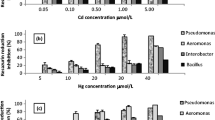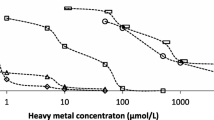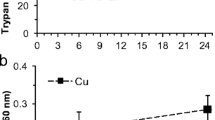Abstract
The effects of three heavy metals (Co, Ni and Cd) on the growth kinetics of five bacterial strains with different characteristics (Pseudomonas sp., Phaeobacter sp. strain 27-4, Listonella anguillarum, Carnobacterium piscicola and Leuconostoc mesenteroides subsp. lysis) were studied in a batch system. A bivariate model, function of time and dose, is proposed to describe simultaneously all the kinetic profiles obtained by incubating a microorganism at increasing concentrations of individual metals. This model combines the logistic equation for describing growth, with a modification of the cumulative Weibull’s function for describing the dose-dependent variations of growth parameters. The comprehensive model thus obtained—which minimizes the effects of the experimental error—was statistically significant in all the studied cases, and it raises doubts about toxicological evaluations that are based on a single growth parameter, especially if it is not obtained from a kinetic equation. In lactic acid bacteria cultures (C. piscicola and L. mesenteroides), Cd induced remarkable differences in yield and time course of characteristic metabolites. A global parameter is defined (ED50,τ: dose of toxic chemical that reduces the biomass of a culture by 50% compared to that produced by the control at the time corresponding to its semi maximum biomass) that allows comparing toxic effects on growth kinetics using a single value.






Similar content being viewed by others
References
Bruins MR, Kapil S, Oehme FW (2000) Microbial resistance to metals in the environment. Ecotoxicol Environ Saf 45:198–207
Cabo ML, Murado MA, González MP, Pastoriza L (1999) A method for bacteriocin quantification. J Appl Microbiol 87:907–914
Cabo ML, Murado MA, Gonzalez MP, Vazquez JA, Pastoriza L (2001) An empirical model for describing the effects of nitrogen sources on nisin production. Lett Appl Microbiol 33:425–429
Cabrero A, Fernandez S, Mirada F, Garcia J (1998) Effects of copper and zinc on the activated sludge bacteria growth kinetics. Water Res 32:1355–1362
Duffus JH (2002) “Heavy metals”—a meaningless term? (IUPAC technical report). Pure Appl Chem 74:793–807
Faust M, Altenburger R, Backhaus T, Blanck H, Boedeker W, Gramatica P, Hamer V, Scholze M, Vighi M, Grimme LH (2003) Joint algal toxicity of 16 dissimilarly acting chemicals is predictable by the concept of independent action. Aquat Toxicol 63:43–63
Gennings C, Carter WH Jr, Carney EW, Charles GD, Gollapudi BB, Carchman RA (2004) A novel flexible approach for evaluating fixed ratio mixtures of full and partial agonists. Toxicol Sci 80:134–150
Gernaey KV, Lantz AE, Tufvesson P, Woodley JM, Sin G (2010) Application of mechanistic models to fermentation and biocatalysis for next-generation processes. Trends Biotechnol 28:346–354
Gikas P (2007) Kinetic responses of activated sludge to individual and joint nickel (Ni(II)) and cobalt (Co(II)): an isobolographic approach. J Hazard Mater 143:246–256
Giotta L, Agostiano A, Italiano F, Milano F, Trotta M (2006) Heavy metal ion influence on the photosynthetic growth of Rhodobacter sphaeroides. Chemosphere 62:1490–1499
Halttunen T, Salminen S, Tahvonen R (2007) Rapid removal of lead and cadmium from water by specific lactic acid bacteria. Int J Food Microbiol 114:30–35
Hielm M, Bergh O, Riaza A, Nielsen J, Melchiorsen J, Jensen S, Duncan H, Ahrens P, Birkbeck H, Gram L (2004) Selection and identification of autochthonous potential probiotic bacteria from turbot larvae (Scophthalmus maximus) rearing units. Syst Appl Microbiol 27:360–371
International Organization for Standardization (1995) Water quality—Pseudomonas putida growth inhibition test. ISO 10712:1995
International Organization for Standardization (2006) Water quality—marine algal growth inhibition test with Skeletonema costatum and Phaeodactylum tricornutum. ISO 10253:2006
Ji G, Silver S (1995) Bacterial resistance mechanisms for heavy metals of environmental concern. J Ind Microbiol 14:61–75
Kooijman SALM, Hanstveit AO, Oldersma H (1983) Parametric analyses of population growth in bio-assays. Water Res 17:527–538
Lowry OH, Rosebrough NJ, Farr AL, Randall RJ (1951) Protein measurement with the Folin phenol reagent. J Biol Chem 193:265–275
Luedeking R, Piret EL (1959) Kinetic study of the lactic acid fermentation. Batch process at controlled pH. J Biochem Microbiol Technol Eng 1:393–412
Martens T, Heidorn T, Pukal R, Simon M, Tindall BJ, Brinkhoff T (2006) Reclassification of Roseobacter gallaeciensis Ruiz-Ponte et al. 1998 as Phaeobacter gallaeciensis gen. nov., comb. nov., description of Phaeobacter inhibens sp. nov., reclassification of Ruegeria algicola (Lafay et al. 1995) Uchino et al. 1999 as Marinovum algicola gen. nov., comb. nov., and emended descriptions of the genera Roseobacter, Ruegeria and Leisingera. Int J Syst Evol Microbiol 56:1293–1304
Mercier P, Yerushalmi L, Rouleau D, Dochain D (1992) Kinetics of lactic acid fermentation on glucose and corn by Lactobacillus amylophilus. J Chem Technol Biotechnol 55:111–121
Mrvčić J, Prebeg T, Barišić L, Stanzer D, Bačun-Drùina V, Stehlik-Tomas V (2009) Zinc binding by lactic acid bacteria. Food Technol Biotechnol 47:381–388
Murado MA, Vázquez JA (2010) Biphasic toxicodynamic features of some antimicrobial agents on microbial growth: a dynamic mathematical model and its implications on hormesis. BMC Microbiol 10:220
Murado MA, Gonzalez MP, Vázquez JA (2002) Dose–response relationships: an overview, a generative model and its application to the verification of descriptive models. Enzyme Microb Technol 31:439–455
Nyholm N, Sorensen PS, Kusk KO (1992) Statistical treatment of data from microbial toxicity tests. Environ Toxicol Chem 11:157–167
Peleg M (1995) A model of microbial survival after exposure to pulsed electric-fields. J Sci Food Agric 67:93–99
Riobó P, Paz B, Franco JM, Vázquez JA, Murado MA, Cacho E (2008a) Mouse bioassay for palytoxin. Specific symptoms and dose–response against dose–death time relationships. Food Chem Toxicol 46:2639–2647
Riobó P, Paz B, Franco JM, Vázquez JA, Murado MA (2008b) Proposal for a simple and sensitive haemolytic assay for palytoxin. Toxicological dynamics, kinetics, ouabain inhibition and thermal stability. Harmful Algae 7:415–429
Şengör SS, Barua S, Gikas P, Ginn TR, Peyton B, Sani RK, Spycher NF (2009) Influence of heavy metals on microbial growth kinetics including lag time: mathematical modeling and experimental verification. Environ Toxicol Chem 28:2020–2029
Skov MN, Pedersen K, Larsen JL (1995) Comparison of pulsed-field gel electrophoresis, ribotyping, and plasmid profiling for typing of Vibrio anguillarum serovar O1. Appl Environ Microbiol 61:1540–1545
Strotmann UJ, Pagga U (1996) A growth inhibition test with sewage bacteria—results of an international ring test 1995. Chemosphere 32:921–933
Vazquez JA, Murado MA (2008a) Mathematical tools for objective comparison of microbial cultures. Application to evaluation of 15 peptones for lactic acid bacteria productions. Biochem Eng J 39:276–287
Vázquez JA, Murado MA (2008b) Unstructured mathematical model for biomass, lactic acid and bacteriocin production by lactic acid bacteria in batch fermentation. J Chem Technol Biotechnol 83:91–96
Vázquez JA, González MP, Murado MA (2004a) Peptones from autohydrolysed fish viscera for nisin and pediocin production. J Biotechnol 112:299–311
Vázquez JA, González MP, Murado MA (2004b) A new marine medium: use of different fish peptones and comparative study of the growth of selected species of marine bacteria. Enzyme Microb Technol 35:385–392
Vázquez JA, González MP, Murado MA (2005a) Effects of lactic acid bacteria cultures on pathogenic microbiota from fish. Aquaculture 245:149–161
Vázquez JA, Mirón J, González MP, Murado MA (2005b) Bacteriocin production and pH gradient: some mathematical models and their problems. Enzyme Microb Technol 37:54–67
Volund A (1978) Application of the four-parameter logistic model to bioassay: comparison with slope ratio and parallel line models. Biometrics 34:357–365
Wachenheim DE, Patterson JA, Ladisch MR (2003) Analysis of the logistic function model: derivation and applications specific to batch cultured microorganisms. Bioresour Technol 86:157–164
Zwietering MH, Jongenburger I, Rombouts FM, VAN'T Riet K (1990) Modeling of the bacterial growth curve. Appl Environ Microbiol 56:1875–1881
Acknowledgements
We wish to thank to Ana Durán and Margarita Nogueira for their excellent technical assistance. Diego Rial Conde was awarded with Isabel Barreto contract, and we are grateful for this financial support (Dirección Xeral de Investigación, Desenvolvemento e Innovación; Xunta de Galicia). This study was partially funded by the Xunta de Galicia (Programa de Consolidación para estructuración das unidades de investigación do sistema galego I+D+I 2008-2010, IN845B-2010/004) and Ministerio de Ciencia e Innovación (CTM2010-18411).
Author information
Authors and Affiliations
Corresponding author
Appendices
Appendix 1. Re-parameterizations of the logistic equation
The explicit form of the logistic Eq. 2 can be written as follows:
For determining the maximum growth rate, it is necessary: (1) to obtain the abscissa (τ) of the inflection point by isolating it from the expression that results by equating the second derivative of the function to zero and (2) to insert the value τ in the first derivative of the function. The results are:
For determining the lag phase, it must be kept in mind that the ordinate of τ is K/2. Thus, the equation of the tangent at the inflection point and its intersection (τ) with the abscissa axis are:
Thus, the re-parametrized logistic equation, with explicit v m and τ, requires isolating μ m and c in 9 and 10, respectively, and to insert the corresponding values into 8:
Moreover, by inserting X = X m/2 in 8, we obtain c = μ mτ, where τ (abscissa of the inflection point) is the time needed to reach the semi-maximum biomass. By replacing c by μ mτ in 8, we obtain another re-parameterized form:
Or, in general, to make explicit the time τ q necessary to achieve a proportion q of the maximum biomass:
Appendix 2. Calculation of DE50,τ
Once the solution of the examined system is obtained by means of a model 6, the ED50,τ, or dose that reduces the biomass to 50% of that produced by the control in time τ, can easily be calculated as follows:
-
1.
Fit the kinetic data of the control to the growth equation in the parametric form L5 to obtain the semi-maximum biomass (X m,0/2) and the time needed to reach it (τ 0). For another proportion q of the maximum biomass, use the form 13.
-
2.
Set an arbitrary initial value (IED50,τ, see next point 5).
-
3.
Calculate the value of biomass (X) that results from applying model 6 by assigning the values IED50,τ and τ 0 to the variables D and t.
-
4.
Calculate the absolute value of the difference \( H = \left| {X - \frac{{{X_{{{\rm m}, 0}}}}}{4}\,} \right| \)
-
5.
Calculate, using the Solver macro in Microsoft Excel, the value of ED50,τ that minimizes H. For ensuring that the algorithm finds the absolute minimum, it is advisable to start with an IED50,τ value associated with a reasonably small value of H.
Rights and permissions
About this article
Cite this article
Rial, D., Vázquez, J.A. & Murado, M.A. Effects of three heavy metals on the bacteria growth kinetics: a bivariate model for toxicological assessment. Appl Microbiol Biotechnol 90, 1095–1109 (2011). https://doi.org/10.1007/s00253-011-3138-1
Received:
Revised:
Accepted:
Published:
Issue Date:
DOI: https://doi.org/10.1007/s00253-011-3138-1




